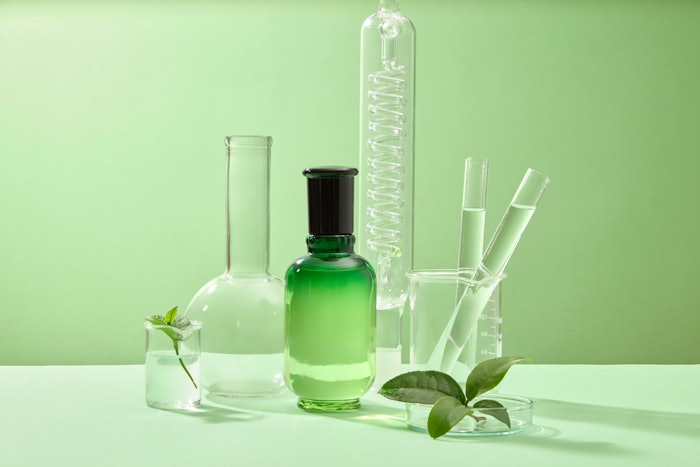
Discarded crop materials that are proven safe are worth considering for beauty applications. Here, a catechin-rich elixir optimized and upcycled from tea leaves is tested for antioxidant, anti-photoaging and anti-senescence benefits in vitro and ex vivo.
Log in to view the full article
Discarded crop materials that are proven safe are worth considering for beauty applications. Here, a catechin-rich elixir optimized and upcycled from tea leaves is tested for antioxidant, anti-photoaging and anti-senescence benefits in vitro and ex vivo.
Fast-moving consumer goods (FMCGs) that contain natural-derived, sustainable and bio-based ingredients have emerged as some of the highest-demanded beauty products, especially in the post-COVID-2019 period. Among these, special attention has been paid to products or ingredients that abide by agricultural sustainability and circular bioeconomy themes;1 tea is presented here as such.
Tea is a universal and well-known medicinal herb that has been consumed in a variety of FMCGs for its tremendous health benefits. While the tender leaves and buds are processed into green, black and oolong teas, the mature leaves are generally not consumed – affording an opportunity for upcycling in support of a circular bioeconomy.
Tea polyphenols are important therapeutic actives for health and aesthetic benefits2 – particularly catechins. These compounds have potent antioxidant effects, DNA-protective properties, and anti-inflammatory and sebum-reducing benefits, among others.3, 4, 13, 14
As such, a catechin-rich extract, dominated by epigallocatechin-3-gallate (EGCG), was derived via a proprietary process5 from non-consumable leaves from Assam bitter tea cultivar – Camellia sinensis var. assamica, which is less costly than C. sinensis var. sinensis – to create a phenolic-, flavonoid- and tannin-enriched skin care elixir. The effectiveness of the elixir against photoaging and senescent cells was then tested as described here.
Materials and Methods
Elixir preparation and characterization: Leaves from Assam bitter tea cultivar, Camellia sinensis var. assamica, organically cultivated in Chiang Rai in the northeast province of Thailand, were harvested, from which the catechin-rich tea elixir was prepared using a proprietary method5 to standardize total phenolic, flavonoid and tannins content (TPC, TFC and TTC, respectively).
Briefly, the extract was prepared by maceration in ethanolic water for a certain period, processed and the solvent was removed under vacuum. The resulting TPC, TFC and TTC were profiled and the catechins were quantified by means of standardized HPLC.6
In vitro antioxidant activities:7 Antioxidant activity was measured by ABTS (2, 2'–azino-bis(3-ethylbenzothiazoline)-6-sulfonic acid), DPPH (1,1-diphenyl-2-picrylhydrazyl) and FRAP (ferric reducing ability of plasma) assays, in a comparison with the standards.
Anti-aging effects in cell culture models:7 The elixir was applied to co-cultured HaCaT and human dermal fibroblasts (HDF) to determine its safety and effects against photoaging, as determined by UV-induced cellular secretions of IL-6, IL-8, MMP-1 and MMP-9.
Anti-aging/anti-senescence effects ex vivo:7 Senescent cells can have deleterious effects in the skin via different mechanisms, including high secretions of IL-6, IL-8, MMP-1 and MMP-9. Referred to as the senescence-associated secretory phenotype (SASP),12 these entities can be measured ex vivo as indicators of senescent and anti-senescent activities. Dermal fibroblasts are most commonly used.
As such, in an ex vivo human skin model, wherein skin tissues were ethically obtained from female Thai donors 35 years or older, the activities of the catechin-rich elixir against IL-6 and MMP-1 were examined, as were its effects on hyaluronic acid and collagen production.
Results
Elixir characterization: The resulting elixir comprised optimized levels of TPC, TFC and TTC content (see Figure 1), wherein EGCG was identified as the dominant catechin. Notably, the extraction process provided greater TPC than ultra-high pressure, microwave, ultrasonic, Soxhlet and reflux extraction (390.68-576.02 mg gallic acid/g extract) carried out using same solvent and extraction time (not shown).8 Similarly, TFC (14.3-38.18 mg quercetin/g extract)9 and TTC (6.0-7.45 mg tannic acid/g extract)10 were notably higher than with standard extraction (also not shown).
Antioxidant effects: The various in vitro assays confirmed the elixir’s antioxidant activities (see Figure 1), where its anti-DPPH ability was higher than that of a Brazilian Assam tea extract prepared by ultrasound-assisted extraction (IC50 = 8.33-16.10 µg/mL),11 as well as Iranian and Ethiopian preparations (IC50 = 167.11-505.5 and 7.3-64.0 µg/mL; not shown).9, 10
Anti-aging effects in vitro: Cocultured HaCaT and HDF, a cellular model that closely mimics skin’s physiology, was treated with the elixir, which was determined to be noncytotoxic to the model (see Figure 2) and protected the coculture against photo-damage. More specifically, UV-induced cellular secretions of IL-6, IL-8, MMP-1 and MMP-9 were clearly suppressed with the catechin-rich elixir, whereby its biologically active marker, EGCG, was indicated.
Anti-aging effects ex vivo: As stated, the elixir’s potential to mitigate senescence was tested in a human ex vivo skin model. Results indicated the elixir suppressed IL-6 and MMP-1, as well as increased the production of hyaluronic acid and procollagen type I (PIP) (see Figure 3).
Conclusion
With consumers’ increased awareness of – and demand for – sustainable, circular products, plants and their byproducts are promising sources for both human consumption and other FMCGs. Industrial crops, especially medicinal herbs whose discarded components are highly available and whose safety is proven, warrant consideration. Tea affords this opportunity.
The catechin-rich, standardized tea extract elixir described here demonstrated significant antioxidant, anti-photoaging and anti-senescence benefits in vitro and ex vivo. Thus, it is proposed as an effective and circular anti-aging active for innovative skin care products.
References
1. Kanlayavattanakul, M., Mersni, D. and Lourith, N. (2024). Plant-derived saponins and their perspective for cosmetic and personal care products. Bot Stud (65)32.
2. Lourith, N., Kanlayavattanakul, M., Chaikul, P., Abe, A. and Takahashi, K. (2023). Tea-derived neuroprotectant demonstrates holistic anti-aging potential. Cosm & Toil 138 32-37.
3. Nualsri, C., Lourith, N. and Kanlayavattanakul, M. (2016). Development and clinical evaluation of green tea hair tonic for greasy scalp treatment. J Cosmet Sci. (67) 161-166.
4. Meetham, P., Kanlayavattanakul, M. and Lourith, N. (2018). Development and clinical efficacy evaluation of anti-greasy green tea toner on facial skin. Rev Bras Farmacogn (28) 214-217.
5. Lourith, N., Kanlayavattanakul, M., Chaikul, P. and Chueamchaitrakun, P. (2005). Thailand Patent Filling No. 2301005294. Assigned to Mae Fah Luang University.
6. ISO. (2025). ISO. 14502-2. Determination of substances characteristic of green and black tea – Part 2: Content of catechins in green tea - Method using high-performance liquid chromatography. ANSI. Available at https://webstore.ansi.org/standards/iso/iso145022005-1121970?srsltid=AfmBOopwVF9cc3_iI6Ocktrsrc-_o_zoe0YwylGf7bv-LRNCF2-Rggb8
7. Kanlayavattanakul, M., Khongkow, M., Klinngam, W., Chaikul, P., Lourith, N. and Chueamchaitrakun, P. (2024). Recent insights into catechins-rich Assam tea extract for photoaging and senescent aging. Sci Rep (14) 2253.
8. Jun, X., Deji, S., Ye, L. and Rui, Z. (2011). Comparison of in vitro antioxidant activities and bioactive components of green tea extracts by different extraction methods. Int J Pharm (408) 97-101.
9. Roshanak, S., Rahimmalek, M. and Goli., S.A.H. (2016). Evaluation of seven different drying treatments in respect to total flavonoid, phenolic, vitamin C content, chlorophyll, antioxidant activity and color of green tea (Camellia sinensis or C. assamica) leaves. J Food Sci Technol (53) 721-729.
10. Bizuayehu, D., Atlabachew, M. and Ali, M.T. (2016). Determination of some selected secondary metabolites and their in vitro antioxidant activity in commercially available Ethiopian tea (Camellia sinensis). SpringerPlus (5)412.
11. ST Saito, G Gosmann, J Saffi, M Presser, MF Richter, AM Bergold. Characterization of the constituents and antioxidant activity of Brazilian green tea (Camellia sinensis var. assamica IAC-259 cultivar) extracts. J Agric Food Chem (55) 9409-9414 (2007).
12. Fitsiou, E., Pulido, T., Campisi, J., Alimirah, F. and Demaria, M. (2021). Cellular senescence and the senescence-associated secretory phenotype as drivers of skin photoaging. J Invest Dermatol. (141) 1119-1126.
13. Bernatoniene, J. and Kopustinskiene, D.M. (2008, Apr 20). The role of catechins in cellular responses to oxidative stress. Molecules. Available at https://tinyurl.com/56fnjt8h
14. Farrar, M.D., Nicolaou, A., ... Rhodes, L.E., et al. (2015, Jul). A randomized controlled trial of green tea catechins in protection against ultraviolet radiation–induced cutaneous inflammation. The Amer J Clin Nutrition. Available at https://tinyurl.com/3a6bhetp.










